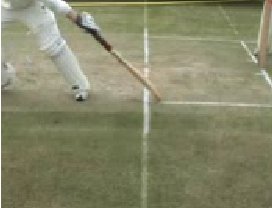Index
- Out of ground Home
- 30.1 When out of his ground
- 30.2 Which is a batter's ground
- 30.3 Position of non-striker

30.1 WHEN OUT OF HIS
GROUND
A batter must have his bat or some part of his person grounded behind the popping crease at his end
Whenever the wicket is put down at his end, the umpire must know whether or not the batter was in his ground
If a running batter grounds his foot behind the popping crease, continues forward, then takes both feet and his bat off the ground, he will be regarded as being in his ground
If the batter grounds the bat (held by the hand) or another part of his person within his ground (the elbow when diving, for example), and provided that the batter has continued forward momentum and subsequently inadvertently loses this contact with the ground when the wicket is put down, the batter will be protected from being Run out
The most common instances when this will be needed are when a batter has dived for his ground or when the bat hits a bump while ‘running it in’ and becomes airborne
Once the batter has gained his ground, and has continued forward momentum, he will be protected
A batter must have his bat or some part of his person grounded behind the popping crease at his end
Whenever the wicket is put down at his end, the umpire must know whether or not the batter was in his ground
If a running batter grounds his foot behind the popping crease, continues forward, then takes both feet and his bat off the ground, he will be regarded as being in his ground
If the batter grounds the bat (held by the hand) or another part of his person within his ground (the elbow when diving, for example), and provided that the batter has continued forward momentum and subsequently inadvertently loses this contact with the ground when the wicket is put down, the batter will be protected from being Run out
The most common instances when this will be needed are when a batter has dived for his ground or when the bat hits a bump while ‘running it in’ and becomes airborne
Once the batter has gained his ground, and has continued forward momentum, he will be protected